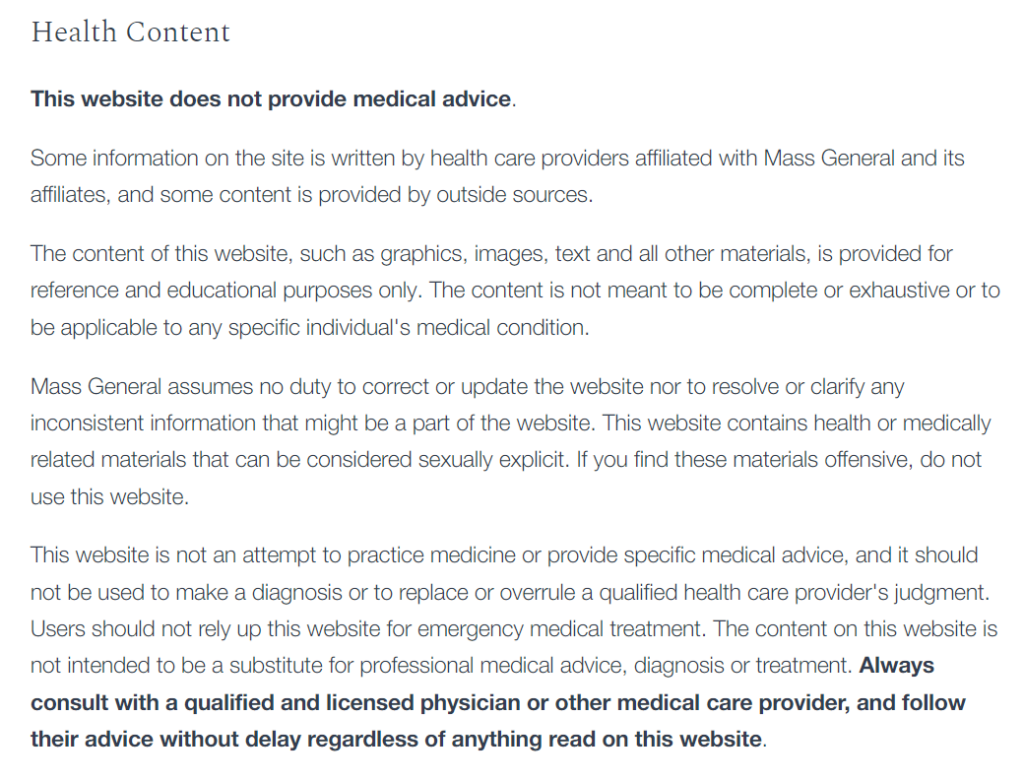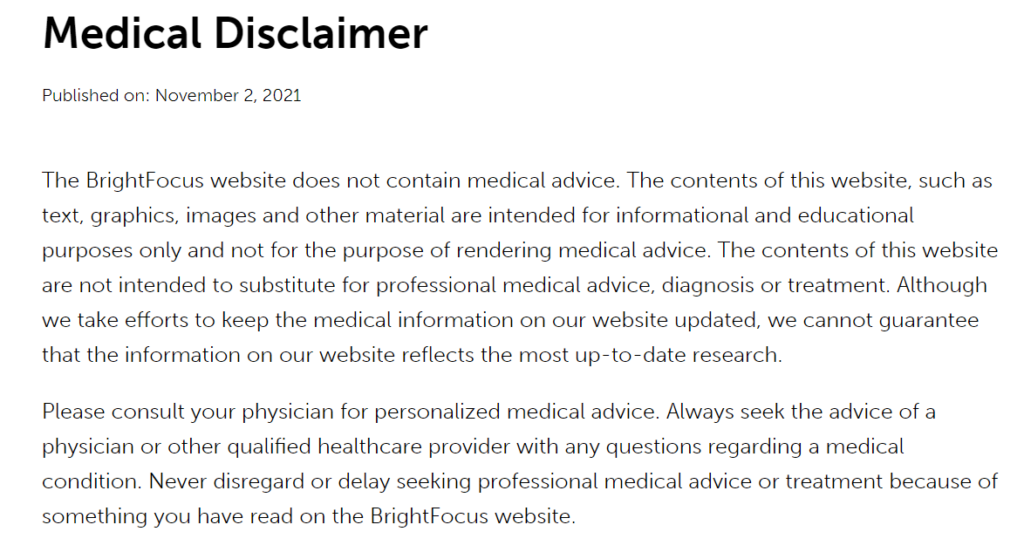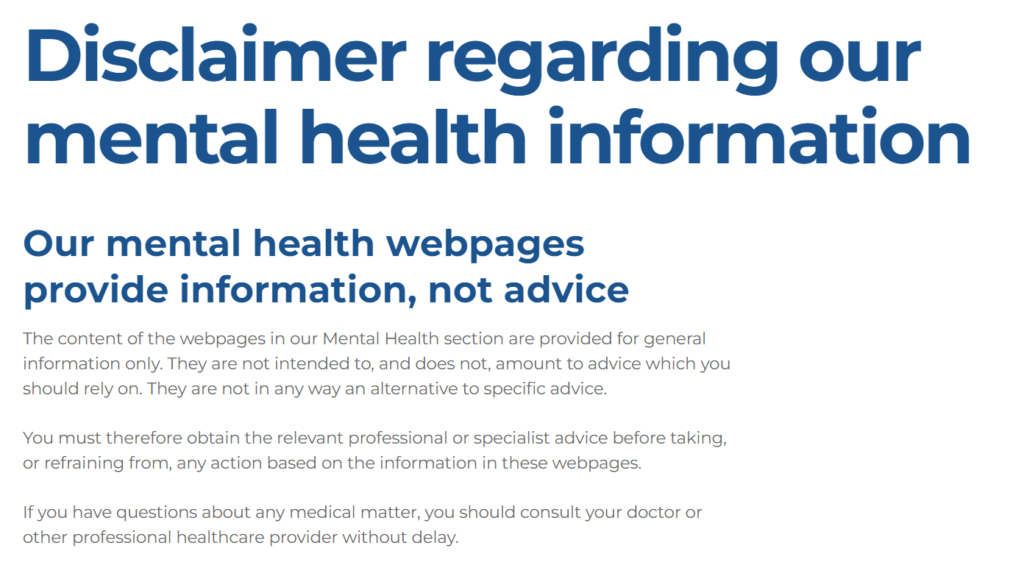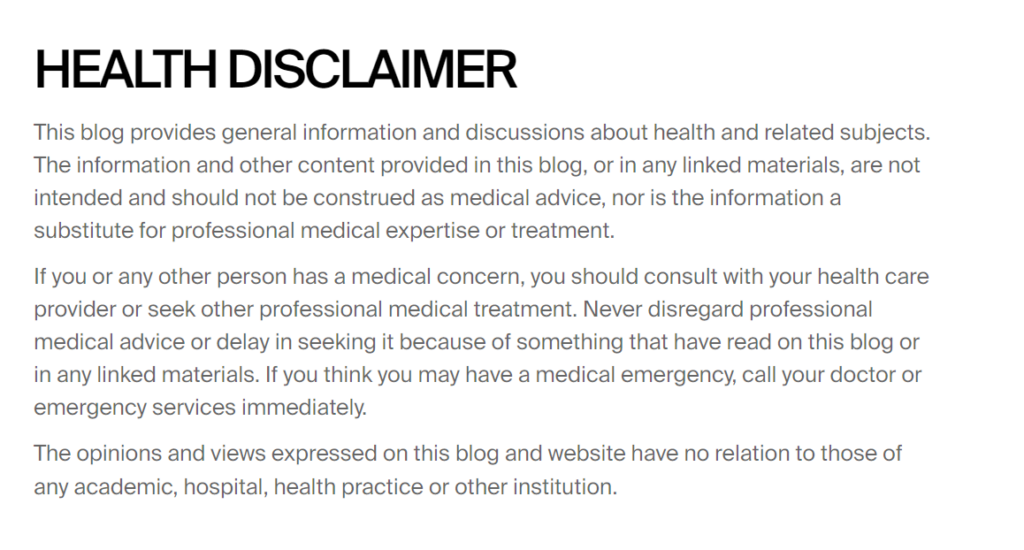Your guide to creating medical disclaimers for your website
If you’re offering health-related guidance, whether as a website owner, blogger, or on another platform, understanding the nuances of medical disclaimers is essential to protect yourself and your audience.
In this guide, we’ll cover what you need to know about creating medical disclaimers, from the differences between the different types, to how to create one and where to place it on your website.
What is medical disclaimer?
A medical disclaimer is a legal statement that limits liability by clarifying that the information provided on a website or any other platform is not intended as a substitute for professional medical advice, diagnosis, or treatment.
It should warn your readers that relying upon the information you provide is at their own risk. Instead, it’s best to consult a qualified healthcare provider for specific advice.
These disclaimers aim to set clear boundaries so that your website visitors understand the limitations of the content provided.
What’s the difference between a medical disclaimer vs. health disclaimer?
The terms “medical disclaimer” and “health disclaimer” are often used interchangeably. However, they have distinct purposes.
A medical disclaimer directly relates to clinical advice, including topics such as diagnosing illnesses, prescribing medications, and recommending medical treatments. These disclaimers are precise and target issues where professional expertise is necessary.
For instance, if a blog discusses the side effects of a medication or treatment options for a disease, a medical disclaimer would emphasize that this content does not replace consultation with a licensed healthcare provider. These disclaimers are critical because inaccurate or misinterpreted information could lead to serious health risks.
A health disclaimer, on the other hand, typically applies to broader wellness topics. This might include advice on exercise routines, nutrition tips, or general lifestyle changes. While these topics impact health, they do not delve into specific medical conditions or treatments.
For example, a health disclaimer might accompany an article offering tips for improving sleep quality. The disclaimer would clarify that the advice is general and not tailored to individual medical conditions. Health disclaimers tend to focus more on promoting informed decision-making rather than addressing urgent clinical needs.
The difference is not just about the focus of the content, but also the level of responsibility and risk involved. Misunderstanding a health tip may cause inconvenience, but misunderstanding a medical directive can result in significant harm. This distinction informs the structure and emphasis of these disclaimer types.
Why is a medical disclaimer important?
Medical disclaimers are essential for protecting both the creator and the consumer of health-related information. We’ll cover the main reasons below.
Legal protection
A primary function of a medical disclaimer is to safeguard against legal liability. Without a disclaimer, users might mistake the information for professional medical advice. If a user acts on this information and experiences harm, the content creator could face lawsuits or other legal repercussions. A well-crafted medical disclaimer clearly communicates the boundaries of the creator’s responsibility, minimizing legal risks.
For example, if a website shares advice on managing diabetes through diet, a disclaimer stating that users should consult their doctor before making any changes protects the site from being held liable for negative outcomes. Legal protection becomes especially critical for platforms offering content on sensitive or high-stakes medical topics.
Encouraging professional medical consultation
Medical disclaimers remind users of the importance of seeking advice from qualified professionals. They reinforce that online content, no matter how detailed or well-researched, cannot replace personalized guidance from a licensed healthcare provider. This is particularly important for issues where self-diagnosis or self-treatment could result in harm.
Managing user expectations
Medical disclaimers help users understand the limitations of the information provided. This kind of transparency sets realistic expectations while fostering trust. For example, a nutritionist who shares meal plans may include a disclaimer to clarify that results vary from person to person and that individuals with specific health conditions should seek medical advice.
Reducing misinformation
In an era dominated by digital content, misinformation about health is a widespread concern. Medical disclaimers remind users to critically evaluate the information they consume and verify whether it applies to their circumstances. This is particularly important for platforms discussing emerging health trends or treatments with limited scientific consensus.
Ethical responsibility
Incorporating a medical disclaimer demonstrates the creator’s commitment to safety and ethical practices. It shows an understanding of the potential consequences of misusing health information and is a proactive approach to minimizing harm.
For example, a site promoting alternative therapies might state that its content is intended to complement, not replace, conventional medical care. This would demonstrate that the creators care about their readers’ well-being, not just promoting their own content.
Who needs a medical disclaimer?
Anyone providing health-related information or services should consider implementing a medical or health disclaimer for their website. This includes bloggers, influencers, app developers, health coaches, and businesses offering products or services in the medical or wellness industries. Even fitness trainers and nutritionists who share advice online can benefit from including a medical disclaimer. By clearly stating the limitations of your expertise or content, you help manage the expectations of your website visitors and reduce potential legal risks.
Different types of disclaimers
Medical disclaimers come in various forms to address specific contexts. Below are some common types along with examples to illustrate their application.
Medical advice disclaimer example
A medical advice disclaimer specifies that the content provided does not constitute professional medical advice.
For instance, a blog discussing the symptoms of a condition might include a disclaimer stating:
This information is for informational purposes only and does not replace professional medical advice. Always consult a licensed healthcare provider for concerns about your health.
The following medical disclaimer on the Massachusetts General Hospital website is a good example.

This disclaimer clearly states that the site content is provided for informational purposes only and does not intend to substitute professional medical advice, diagnosis, or treatment. This disclaimer is necessary even on a hospital’s website since readers could mistake the content for official medical advice.
“Please consult your doctor” disclaimer
This disclaimer emphasizes the importance of consulting a healthcare professional before acting on the information provided. For instance, a blog discussing the symptoms of a condition might include a disclaimer stating:
The content on this website is not intended to diagnose, treat, or prevent any condition. Please consult your doctor before making any changes to your health regimen.
You can see this type of disclaimer in action on the BrightFocus website.

As you can see, this disclaimer mentions how BrightFocus’s content does not substitute for medical advice and that website visitors should consult their GP for specific questions and concerns.
“Educational purposes only” disclaimer and example
An “educational purposes only” disclaimer makes it clear that the information is intended solely for learning and should not be used for self-diagnosis or treatment.
This type of medical disclaimer may say:
All content on this platform is provided for educational purposes only and is not a substitute for medical advice, diagnosis, or treatment.
The Caring Center of Wichita highlights this in its website disclaimer:

They explicitly say that all of their content is for educational purposes only and that it should not replace medical advice from a doctor.
Mental health disclaimer example
A mental health disclaimer is a legal statement that is similar to the above examples but with a distinct purpose. This type of disclaimer relates specifically to content regarding mental health. It informs your website visitors that the content provided on your website is for informational and educational purposes only and that it should not be considered a substitute for professional medical or mental health advice, diagnosis, or treatment.
A mental health disclaimer might say something like:
The mental health advice shared on this website is not a substitute for professional psychological or psychiatric care. If you are experiencing a mental health crisis, please contact a professional or emergency services immediately.
For example, look at the following disclaimer from the Royal College of Psychiatrists.

This disclaimer highlights that, despite the website’s name, the information provided is general and does not replace professional medical advice.
“I am not a doctor” disclaimer
A “not a doctor” disclaimer is commonly used by individuals who share health advice but do not hold a medical license.
If you’re sharing advice and need to communicate that you’re not a professional in the field, you could say:
I am not a licensed medical professional. The information shared here is based on personal experience and should not be considered medical advice.
You can see an example of this on this screenshot from a blog post on the website Medium.

This author highlights how their blog post is only one personal story and should not be taken as a general rule.
Drug disclaimer examples
Drug disclaimers are legal notices that explain the risks and limits of drug-related content or products. They make it clear that the information provided is for learning only and is not a replacement for professional medical advice.
If your company produces similar content, you may need to add a medical drug disclaimer that states, for instance:
This website does not endorse or recommend any specific medications. Always consult a qualified healthcare provider before starting or stopping any medication.
For example, the Pfizer website includes the following disclaimer.

This disclaimer acknowledges that the Pfizer website naturally includes pharmaceutical information. However, individuals should speak with their doctors for medical advice or diagnosis.
Health and wellness disclaimer and example
A health and wellness disclaimer is a legal notice that tells users that health and wellness content is for information or education only. It is not professional medical advice and should not replace consulting a healthcare provider.
This type of disclaimer is relevant on any platform that produces health and wellness content and might say:
The health and wellness tips provided here are for informational purposes only. Consult with a professional before starting any new diet or exercise program.
For example, the Tony Robbins wellness website adds the following health disclaimer.

While the blog may cover health and wellness topics, this health disclaimer informs their website visitors that it’s not a substitute for medical advice.
Supplement disclaimer
A supplement disclaimer informs readers that statements regarding dietary supplements have not been evaluated by regulatory authorities and are not intended to diagnose or treat conditions.
If your website sells health or dietary supplements, you could include the following:
These statements have not been evaluated by the FDA. This product is not intended to diagnose, treat, cure, or prevent any disease. Consult your healthcare provider before using this supplement.
Here’s an example of this type of medical disclaimer on the website Vitamin Express:

It’s worth noting that this type of disclaimer is required by Title 21 of the Code of Federal Regulations in the United States, and other regulations elsewhere, when a manufacturer claims the structure or function of a supplement or certain other claims in dietary supplement labeling.
How to create a medical disclaimer?
Creating an effective medical disclaimer involves several steps to ensure it is clear, comprehensive, and legally sound. Below is a detailed guide.
Identify the purpose of your disclaimer
Determine the specific type of information you are sharing and the risks associated with it. For instance, are you providing fitness advice, discussing medical treatments, or selling health-related products? Knowing the scope of your content helps you tailor your disclaimer to your audience’s needs.
Use clear and accessible language
Write your disclaimer in simple, straightforward terms that are easy for a general audience to understand. Avoid using technical jargon or overly complex sentences. The goal is to clearly communicate the limitations of your content.
Include key statements
Clearly state that your content does not replace professional medical advice. Emphasize the importance of consulting a qualified healthcare provider. Lastly, highlight any specific limitations, such as if the content is intended for educational purposes only.
Address specific contexts
Depending on your content, you may need to include specific disclaimers for mental health, supplements, fitness advice, or drug information. Tailor each disclaimer to the unique risks it addresses and audience expectations. Depending on your site’s content and topics, you may need to address more than one, e.g. fitness and supplements.
Consult a legal professional
To ensure your disclaimer is legally compliant with relevant laws, seek advice from a qualified legal expert. They can help you draft a disclaimer that aligns with local laws and addresses all potential liabilities.
Review and update regularly
As your content evolves, so should your disclaimer. Periodically review your disclaimer to keep it relevant and accurate. For example, if you expand your content to include new topics about mental health, when before it only included fitness advice, update your disclaimer accordingly.
Where to place a medical disclaimer on your website?
The placement of a medical disclaimer is as important as its content. It should be visible and accessible to your website visitors. Common locations include:
- Footer: adding the disclaimer to your website’s footer means it will appear on every page
- Terms and Conditions: include the disclaimer in your terms and conditions for comprehensive coverage
- About page or FAQ section: if your site has a FAQ or About page, consider placing the disclaimer there for easy reference.
- Content-specific areas: for blogs, apps, or videos, place the disclaimer directly on relevant pages or at the beginning of the content.
The disclaimer information can (and potentially should) be presented in multiple locations if relevant. Ensure that the disclaimer is easy to read, using clear fonts and formatting. An alternative is to include hyperlinks to a full disclaimer page within your content.
Implement medical disclaimers to protect your audience
Medical disclaimers are indispensable for anyone sharing health-related information online. They protect both the content creator and the audience by setting clear boundaries and encouraging professional consultation when necessary.
By understanding the different types of disclaimers and tailoring them to your content, you can minimize legal risks and foster trust with your users. Remember to place your disclaimer prominently and review it regularly to keep it relevant and compliant with regulatory requirements.
When in doubt, seek legal guidance to create a disclaimer that safeguards your platform and its users.